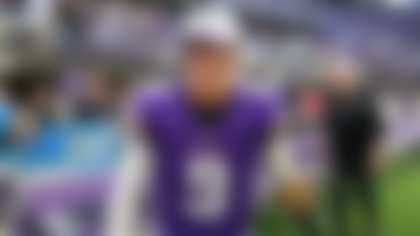If the adage about defenses winning championships still holds true, the New York Giants have more than a puncher's chance at capturing the Lombardi Trophy in a few weeks.
Led by a defensive unit that is starting to flex its muscles, the Giants are one of the hottest teams in the postseason. But standing in their way is a Green Bay Packers offense that has torched the rest of the league behind the MVP-caliber play of Aaron Rodgers.
After watching the Giants' past three games and their Week 13 match-up with the Packers, I have five suggestions for New York defensive coordinator Perry Fewell as he tries to stop Green Bay.
Keep it simple
The Giants' defense improved dramatically over the final month of the season, keyed by Fewell's decision to simplify the game plan.
He scrapped the complex coverage that led to frequent blown assignments in the back end and reinstalled the basic schemes that helped the Giants lead the league in takeaways a season ago. Fewell also eliminated on-field checks and audibles based on offensive formations, reducing the uncertainty in the minds of defenders. As a result, the Giants are swarming to the ball and have started making disruptive plays again.
In their three most recent games, the Giants forced three takeaways, recorded 10 sacks and surrendered only 28 points. This is a dramatic turnaround from a three-game stretch earlier this season, in which they allowed 114 points to the New Orleans Saints, Green Bay Packers and Dallas Cowboys.
Win up front
The strength of the Giants' defense is unquestionably the deep and talented defensive line. The eight-man rotation of Justin Tuck, Jason Pierre-Paul, Osi Umenyiora, Rocky Bernard, Linval Joseph, Chris Canty, Dave Tollefson and Mathias Kiwanuka (who plays on the line in nickel packages) is by far the league's best. Its ability to overwhelm opponents at the point of attack resulted in 48 regular-season sacks, third-most in the NFL.
The Packers' offensive line has struggled to protect Rodgers at times, and could face a significant challenge in trying to stop the Giants' front, especially on the edges. Pierre-Paul and Tuck are skilled speed rushers with the burst to collapse the pocket from the outside. Their athleticism and agility gave Packers offensive tackles Marshall Newhouse and Bryan Bulaga issues in Week 13; Umenyiora's return will just make their jobs more difficult this weekend. Although veteran offensive tackle Chad Clifton is slated to start, the lingering effects of an injury might prevent him from keeping Rodgers secure in the pocket.
In their past three games, the Giants have been able to generate consistent pressure with their front line. From straight four-man rushes to edge pressures complemented with inside twists, Fewell has unleashed his talented front on the opposition with outstanding success.
Against the Packers, however, Fewell must have a plan for confining Rodgers to the pocket. In Week 13, Rodgers scrambled for 32 yards on four rushes, and his ability to find a running lane led to a few critical first downs. If the Giants can generate consistent pressure on Rodgers while keeping him trapped, they might be able to cause some game-changing miscues in the passing game.
Use a variety of 'two-deep' coverage
The best way to frustrate an explosive offense is to limit its opportunities to generate quick-strike points. Under Mike McCarthy, the Packers have become one of the best deep-ball teams in the NFL. They attack vertically from a variety of formations and personnel groupings, but the majority of their deep throws come against single-high safety coverage.
Rodgers excels at manipulating defenders with his eyes. His ability to move safeties out of the deep middle position creates big-play opportunities on the backside. In Week 13, he repeatedly burned the Giants for big plays against single-high safety looks. He would identify the coverage during his pre-snap read and, after briefly holding the safety in the middle of the field, would immediately attack deep outside. Rodgers' ability to manipulate the safety led to a 27-yard completion to Jordy Nelson on the game-winning drive in Week 13. His 20-yard touchdown to Greg Jennings was also completed against a single-high safety look; after spotting Deon Grant floating in the middle of the field, he quickly connected with Jennings on a skinny post over the top of the coverage.
To guard against the deep ball, the Giants must use some form of 'two-deep' coverage throughout the game, regardless of formation, personnel grouping, down or distance. In Week 13, the Giants extensively featured three different variations of a 'Cover 2' defense to discourage deep throws, successfully keeping the ball in front of their defenders. Their primary coverage was the traditional 'Tampa 2' with the middle linebacker running down the middle of the field to create a hybrid three-deep zone. While the coverage didn't prevent Rodgers from getting into a rhythm, it did produce a turnover, with Chase Blackburn running under a deep square in against the coverage to pick off a pass.
The Giants also played a heavy amount of '2-Man' against the Packers. The corners would walk up and press the receivers while maintaining inside leverage and hopping into a trail position. Safeties Kenny Phillips and Antrel Rolle played over the top in deep half positions to prevent Rodgers from taking shots downfield. The coverage eliminated some of the quick throws (slants and hitches) that are a big part of the Packers' offense and forced Rodgers to throw a number of passes to Jermichael Finley and others on "stick" routes (five-yard outs from a slot position).
Although Finley finished with a big day (six catches for 87 yards and a score), the extensive use of 'two-deep' coverage disrupted Rodgers for parts of the day.
Have a plan for the Packers' empty formations
The Packers will routinely align in an empty formation to dictate coverage to their opponent. Defensive coordinators will blitz the formation or drop into soft zone coverage, which creates easy throwing lanes for Rodgers. The Packers aren't afraid to use this formation anywhere on the field, but it is particularly dangerous in the red zone, where the horizontal stretch creates a window for pinpoint throws.
The Giants defended the formation well by using a '2-Hole' coverage scheme ('two-deep' with six underneath defenders in short zones) with a three-man rush, with Tuck abandoning his rush responsibilities to act as a short-area defender over the middle of the field. He would bump the first crossing route in his area and read Rodgers' eyes to react on the throw. The harassment of the underneath route would disrupt the timing of the play and routinely forced Rodgers to scramble or throw the ball away prior to the pocket collapsing.
Maintain coverage discipline when Rodgers scrambles.
The Giants learned in Week 13 that Rodgers is still capable of making plays, even against the right defensive call. He tormented the defense by buying time with his feet, allowing his receivers to shake free from coverage. The combination of scrambling and improvising resulted in several key first downs for the Packers.
To neutralize Rodgers' ability to move the chains on impromptu plays, the Giants must display outstanding discipline in coverage. Defenders must plaster the receivers in their area and ignore Rodgers' potential as a runner. Although his scrambles may extend drives, his penchant for big plays outside of the pocket should make stopping the pass the priority when he flees.
Follow Bucky Brooks on Twitter @BuckyBrooks












